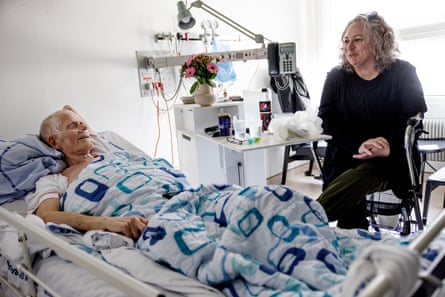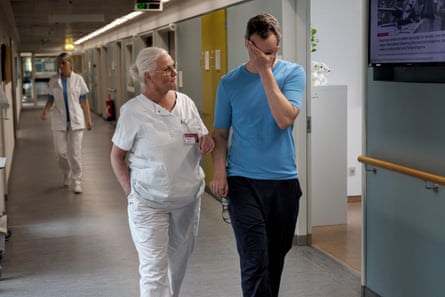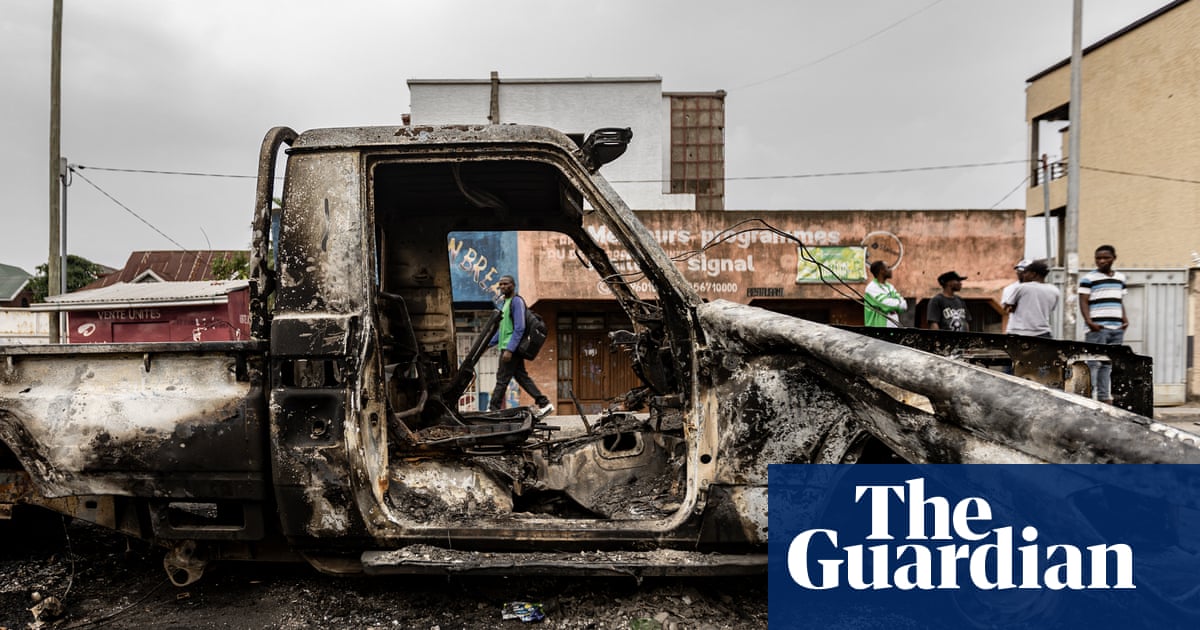René Damgaard, 67, lies in a hospital bed in the palliative care unit at Hvidovre hospital outside Copenhagen. It’s the first evening of May, and the window is open, letting mild air and the sound of a blackbird singing into the room.
“This is the kind of weather you love the most. When you usually stand and fish at the sandbank,” says his niece, 53-year-old Mette Damgaard. She is leaning over the bed, her face very close to his. She has been sitting like this for a long time.
René has his eyes closed, and his mouth is slightly open. The evening light falls across his gaunt face, and he looks as though he is sleeping. He is not; he is dying.
“I will take care of you,” Mette whispers.
He nods. She strokes his hand and squeezes it.
“You can let go now, René.”
There is a moment of silence. Then he whispers: “Remember to say goodbye to everyone from me.”
“I will, René. I promise.”
The way we die is a topic of a heated debate in Denmark, as in many other countries including the UK. The government wants to introduce medical aid in dying, and in 2023 set up a committee, which presented its various opinions in January this year. Palliative care is often highlighted as a counterweight to the offer of assisted dying. To witness the treatment of terminally ill patients, I was given access to the palliative care unit, section 126, at Hvidovre hospital for 10 days in April and May 2024.
Unlike the rest of the hospital, section 126 isn’t focused on cure but on relief. In this unit, terminally ill patients like René receive help to deal with their pain, nausea, and other symptoms from doctors and nurses specialising in palliative care. But the staff in this section don’t just administer morphine and methadone through IVs and injections. They also assist patients and their families with the grief of saying goodbye, the pain of leaving life and the fear of death.
“Many of the patients we receive are referred due to physical pain, but they can also experience breathlessness, anxiety and existential suffering. We call this ‘total pain’,” says Dr Johan Randén. Originally from Malmö, he trained as a general practitioner in 1996 and has been working in palliative care for more than 10 years. He has encountered several patients who talk about assisted dying: “Some of them think, on receiving their diagnosis, that they want to end their life then and there, and might as well get it over with. But they can also live. And I find that when they receive the right support, they let go of that thought.”
Sigrid Nielsen, 65, an experienced nurse, adds: “It’s healthy people who want to introduce assisted dying. But the patients we meet here want to live. They do not want to die.”
Every morning in the palliative care unit starts with a meeting in the staff room at the end of the hallway. On this Monday in April, doctors, nurses, and the unit’s psychologist and social worker gather around a table to talk through the patients in their care. A middle-aged man is in such severe pain that he can barely be touched; another needs to be discharged to a hospice; a third patient requires a Polish-speaking interpreter; and then there’s a male patient who is in a very bad psychological state. He feels lonely, hasn’t slept all night and wants to hold hands all the time, says Nielsen. “He is really in a deep crisis.”
The man is not psychotic or suicidal, but he needs someone who listens. “We can’t change his life circumstances, but I’ve told him: ‘You need to stay here until you feel safe’,” she says.
The psychologist has made an appointment with him, and he has also been asked if he wants to talk to a priest. After half an hour, everyone gets up. An alarm flashes above the door, nurses are needed in several rooms and doctors are preparing for rounds. Some of them are going on home visits with the unit’s palliative mobile care team.
A small sign outside each room has a handwritten message, name and a drawing. “Welcome René” it says outside room 14 next to a drawing of a tree.
René was admitted on Monday morning. He came from the hospital’s pulmonary unit, where he had been for almost a month. René’s eyes look large in his hollow face, and his hair is a bit dishevelled. His bones are prominent at his shoulders and wrists, and his muscles have shrunk. He started having back pain before Christmas, and the doctor thought it might be a herniated disc. He also got tired a lot and felt cold. He was sent to a physiotherapist, who couldn’t help him, and one day in late March an ambulance brought him to the hospital with severe pain. The paramedics thought it was intestinal obstruction.
“But then they found cancer everywhere,” he says. The disease had started in his lungs but had spread to his liver and bones.
Nielsen enters the room and reminds him to drink more. He promises. “As long as it’s only water,” he says. He quit drinking in 1996, he tells Dr Randén. “Well done,” says Randén. He sits on the bed and asks how they can help him. He’s short of breath, lacks appetite, he says, and then there’s the pain, a burning sensation. It sits under his shoulder blade.

“I know what’s going to happen,” says René.
“What’s going to happen?” asks Randén.
“My life is coming to an end.”
“What do you think about that?” asks Randén.
“It’s too early, but it is not up to me to decide.”
He was offered chemotherapy but declined. He doesn’t know if he has a week or a month left to live. “And chemo makes you really sick. I’d rather spend my time feeling good.”
Randén understands, he says. “That’s not how you should spend your energy.”
He explains that it’s important to speak up as soon as he feels the pain. “Pain is like fire. You can easily blow out a candle. But if the fire spreads and the whole kitchen goes up, it’s hard to extinguish. It takes time for the medicine to work, so you need to tell us as soon as you feel the first flame.”
René nods. “I’ve never been good at asking for help,” he says.
As soon as the pain is under control, he wants to move back to his flat, where he lives alone. His niece has rearranged his flat, and everything is ready for him to spend his final days there.
“Do you have any children?” asks Randén.
“I have a son,” says René.
“Do you have a good relationship with him?”
“No.”
“Does he know you’re sick?”
“No.”
Out in the hallway, Randén stops and talks to Nielsen. “Maybe we should ask René if he wants to write a letter to his son,” he suggests.
Randén says one of his most important tasks is to listen to the patients.
“You can run all kinds of blood tests and scans, but if you don’t talk to the patients about what they want, it’s pointless. You must talk to them. And touch them,” he says.
It’s the experience of Randén and his colleagues in the palliative care unit that no one else in the healthcare system has talked to the patients about the fact that treatment could extend life yet diminish its quality, especially towards the end. “Many doctors shy away from talking about death. They keep treating the patients until the very last moment before they finally say: ‘Now there is nothing more we can do.’ But then there is no time left for the patient to prepare themselves for death,” says Randén.
There are three things that are important for someone dying to get the opportunity to say to the right people, Randén says: “Forgive me. I forgive you. And I love you.”
“Life is too short for bad coffee,” says Niels Abrahamsen, who is 63.
He pours freshly ground coffee into a glass pot from a small bag his wife, Rikke, has brought. He smells the freshly ground beans and says: “Ahhh.” On his bedside table is a box of luxury chocolates. Life is also too short for bad chocolate.
Abrahamsen often uses that phrase. He is a bon vivant. He was diagnosed with stomach cancer in January 2020, but even with a death sentence hanging over him for four years, he has not lost hope, he says. In February, he had a stomach bleed, and after radiation therapy to stop it, he experienced severe pain. In recent weeks there has been a buildup of fluid in his abdomen, and a few days ago he was admitted to the palliative care unit to relieve his discomfort.
Abrahamsen’s approach to illness is holistic, he explains. On his bedside table are various “exquisite” dietary supplements, as he calls them. He does not like medication – especially not chemotherapy, of which he has had about 30 treatments. He likes the palliative unit compared with the gastro unit in the hospital where he was initially admitted and where everything was “complete chaos”. “They are more professional here, more experienced, and they have time to sit down and hold your hand,” he says.
He has settled into his room with a yoga mat and a stack of magazines. He also unpacks a Bluetooth speaker his wife has brought so he can listen to good music. Because life is also too short for bad sound.

The doctor enters to check on him. His abdomen is swollen with fluid, and during the night he paces the hallway restlessly. Randén wheels in an ultrasound machine, sits on the edge of the bed, scans, and gently feels Abrahamsen’s stomach. They discuss whether to try to drain some of the fluid or wait a while.
“We’ll take it step by step and see what we can do for you,” says Randén. He sits for a moment, quietly, patting his patient’s hand. Abrahamsen begins to cry.
“What’s happening?” Randén asks.
“It’s you, Johan. You are the most attentive doctor I have ever met,” says Abrahamsen. He covers his face with his hands as tears stream down.
“It’s not easy, I know,” says Randén.
The nurses move quickly down the corridors, keeping an eye on the clock and the flashing alarms. However, when they enter the patients’ rooms, the pace is often different.
They speak softly and take their time. Patients and relatives talk about a unique calm atmosphere in the unit – a stark contrast to the hospital’s other departments.
One afternoon, a middle-aged man enters the corridor. In his hands, he holds two large boxes of cream puffs, which he places in the nurses’ office. His wife died in the unit a month ago. They were admitted together up until her death.
“We had talked about her coming home to die, but she felt most secure here,” he says. Now he wants to say thank you. “I promised my wife that I would come back and properly say goodbye to the staff.” But it was difficult to walk through the door to the unit. “This is where I saw my wife for the last time,” he says.
The man gets a cup of coffee and talks at length with two of the nurses. One of them places a hand on his shoulder. His eyes fill with tears.
“We don’t just take care of the patients – we also take care of the relatives, their emotions and their grief,” says Nielsen later.
She has saved some of the many thank-you cards and letters she has received over the years. There are also several memorial cards from patients’ funerals she has attended. “You don’t just distribute food, make the beds and give medication. You also embrace them and care for them,” she says.
In room 11, Liv Simonsen is being visited by one of her three daughters and two grandchildren.
The youngest crawls into her bed and cuddles up to her. The girl doesn’t say much but shows with her hand how old she is. Five fingers. On the wall of the room hangs a child’s drawing of a princess in a castle.
Simonsen is 70 and had just retired from her job as a speech therapist when she was diagnosed with breast cancer in 2020. She was declared cancer free in 2021. But in January she experienced back pain. “The doctor thought it was muscle pain and just wanted to give me pills,” she says.
But when she was admitted to casualty with severe pain, they sent her for further examination. It turned out that the cancer was back and had spread to her spinal cord and bones. Now it is incurable. When Simonsen was admitted to the palliative unit last week, the pain was so intense she couldn’t get out of bed. She has never been able to sit still. Three months ago, she was swimming and playing volleyball and padel.
“And now here I am,” she states quietly. She lives in a townhouse in Albertslund with her husband, Jens. Together they have five children and 10 grandchildren. He is also admitted in the room – his bed is placed close to hers.
The oncologist’s plan is to keep the disease at bay with oral chemotherapy. But only if Simonsen recovers strength enough to move around. Otherwise they will have to stick to life-prolonging treatment, she explains. And first the pain must be under control.
A nurse brings a small brown pill that Simonsen needs to take to muster the strength for later when her sister comes to visit. Randén prescribed the morphine-based drug oxycodone. Initially, she wouldn’t take it.
“I freaked out when he mentioned it because I’ve heard on TV how people can become addicted to opioids.” Randén explained to her that it was for the pain. Not for fun. “And now I’m glad. It’s really nice not to be in so much pain.”
But when the pain is under control, you start to think, she says. “And then you get sad. I told Sigrid earlier that if I start crying, it feels as if I can’t stop,” she says. “But when my grandchildren are here, I don’t cry.”
Randén looks at the CT scans of René Damgaard on a computer.
It looks like a map – his bones, lungs, and other internal organs depicted like islands in a sea of white and grey. Randén scrolls, zooms in and points to numerous small and large black spots and shadows. Cancer.
“There, there and there. It’s everywhere and it’s causing him pain,” Randén says. Even though they can’t cure or treat the cancer, there is plenty they can do to give him relief, he says.
In room 14, René has dozed off with a Crossword & Quiz magazine in front of him on the duvet. His niece, Mette, drops by straight from her job as a department head at a school nearby. She has brought a Popsicle for him called Champagne.
“This is the only type of champagne we use to celebrate,” she says. They both laugh. She has big curly hair and smiles a lot. She is the daughter of René’s older brother, and there are only 14 years between uncle and niece.
Her father died of cancer. “When René is no longer here, there won’t be anyone around any more who has known me my entire life,” says Mette.
René worked in shipping, as a hospital porter and in IT. While he has been in the hospital, he turned 67 and is now officially retired. He was supposed to be spending all his time on his hobby: fishing. Instead, he is scheduled to be discharged on Monday to die at home, and his niece has applied for care leave so she can be with him as much as possible.
“You can sit by the window and see the new leaves on the beech hedge, and we’ll eat good food. I’ve stocked up on frozen meals,” she says. She has arranged home care from the municipality up to 12 times a day. Still, she worries about her uncle being in pain.
For the doctors and nurses in the unit, it’s important to prepare the family and the patients for death so it doesn’t end in helplessness and chaos. But it’s not always possible, says Randén. The patients hardest to handle are those who don’t want to talk about death and do everything they can to avoid facing it. “Especially young people, and mothers with small children. They fight with everything they have – understandably,” he says.
Even though most dying people want to be at home, patients and relatives can become uncertain or overwhelmed in the final days and hours. And then the dying person gets admitted to hospital, stabilised and perhaps sent home again, only to end up in the hospital again a few days later.
“Sometimes it ends up in what I call ‘blue-light deaths’, where a patient is rushed in by ambulance, dies on the way, is resuscitated, and maybe doesn’t regain consciousness and never gets a chance to say goodbye. That’s not a dignified death,” says Randén.
During the night just before the weekend, René gets a fever. He wakes up with chattering teeth. The next morning his skin is still sweaty. Randén examines him first thing.
“I think you have pneumonia. So take it easy – no dancing today,” the doctor says, prescribing antibiotics. “We need to get you back on your feet. You still want to go home on Monday, right?”
René struggles through a handful of pills with the help of a protein drink. Nielsen arrives.
“I’ll open the curtains so we can get some sunlight in. It’ll make the day a bit better,” she says.
She starts preparing everything for his discharge so he will get all the help and care he needs for his final days. Wound care for his bedsores; a form to say his condition is terminal so all medication is free of charge. She also notes down the phone number for the emergency nurse so he and his niece have someone to call. But Nielsen doubts he will make it until Monday morning. Pneumonia is serious in his condition.
“He might die over the weekend,” she says, adding: “I’m just being realistic.” The most important thing is that he is not in pain.
“We are chasing the good days.”
For Liv Simonsen in room 11, it’s a bad day after several good ones.
She feels nauseous and sits up in bed with a small plastic pill cup of medicine in front of her and a smoothie beside her bed. She can’t get either of them down because she has an upset stomach. It started last night.
“I threw up and got really tired. Like I was hit with a hammer,” she says.
Three small pills remain. Randén enters and sits down on the edge of the bed. He listens to her stomach with a stethoscope.
“Nausea can have many causes. Sometimes it’s an imbalance in the body. Sometimes it’s the medication. Sometimes it’s anxiety. It all feels the same,” he says.
Nielsen has joined them. She wants Simonsen to get out of bed. “You need to get up and brush your teeth, and then we’ll get you in the wheelchair and wrapped up so you can sit on the terrace in the sunshine. It’s better for your appetite, and your mood,” she says firmly. Simonsen is grateful for the way she is treated. That Nielsen constantly reminds her to make the most of the time she has left.
Niels Abrahamsen has had trouble sleeping. He usually stays active by doing exercises but hasn’t had the energy in recent days.
He is increasingly worried that the fluid in his abdomen is due to the cancer spreading. He has asked for a CT scan. He keeps up with music – both big stars and new names – and he has tickets for a Bruce Springsteen concert in July and a local music festival in August. He also bought tickets for the Euros in Germany, which he hopes to attend with his 19-year-old son, who graduates from high school in a couple of months. “It’s going to be huge. I must be there,” he says.
However, he knows he can’t travel in his current condition. He takes more morphine than he’d like. “And then my stomach gets constipated, and I get sluggish and forgetful,” he says.

He takes a walk on the grass outside the hospital and performs an exercise routine in his socks among daisies and bushes. He does this every day, all year round, at home in his own garden, he says.
“Now I feel almost reborn,” he says afterwards.
René is scheduled to be discharged on Monday morning, but that doesn’t happen.
Over the weekend, he gets delirium – a condition with hallucinations that often affects the dying and very sick. He has seen visions of his mother and father, and when Nielsen arrives, he is crying.
Nielsen doesn’t think he’s well enough to go home.
“What are you afraid of? Are you afraid to die?”
The way she says it sounds like a mix between a question and a statement. Damgaard doesn’t respond.
“I will make the decision for you now. I can’t send you home when you’re in this state,” she says.
René cries so hard the bed shakes. He raises his hands to his face. “Bullshit,” he finally says.
“It’s good for you to cry. It’s OK to let it out,” says Nielsen, stroking his short grey hair. A little later she gives him a shot of sedative and makes a call to cancel the transport home. She also gets hold of his niece, Mette.
René was supposed to get a visit at home from his son, whom he hasn’t seen in years. Mette arranged it. She promises to make sure the son pays a visit to his father at the unit instead.
Randén has just arrived. He hasn’t even taken off his backpack when he goes in to see René. He is still crying and upset about having to cancel the transport home. The doctor explains the hallucinations. About 80% of dying patients experience them. It feels like dreaming while you’re awake. Sometimes the patients see people from their past. It can be frightening.
The room is quiet. Randén holds his patient’s hand and just sits there. For a long time. Eventually René calms down. The medicine is working. Nielsen walks down to the nurses’ office with the bag of medication René was supposed to take home.
“I had packed everything. But things never go as planned here,” she says.
She talks about a young female patient who was severely troubled by hallucinations before she died. “It was very scary. She saw shadows that wanted to take her. They surrounded her in the room.” Nielsen moved her patient’s bed into the hallway and lay down with her, holding her. “It was the only thing that helped. She was terrified.”
Every Monday, a musical duo visits the unit to play for the patients.
It consists of a guitarist and a singer who knock on each door and ask if they can come in to sing a song. They are welcomed into three rooms. They play Somewhere Over the Rainbow to an 80-year-old woman who has been in the ward for a few days. She appears to be asleep, and 20 minutes after the musicians leave, she takes her last breath.
Later that day René’s niece, Mette, arrives. He feels better after the decision has been taken about staying in the ward. He has eaten two cups of yoghurt, and in a few hours his 36-year-old son, whom he hasn’t seen in four years, is coming to visit.
Now that the meeting is approaching, he is worried that his son might be angry with him. “But he wouldn’t come if he was very mad, I guess,” he says. Although he has been sober since 1996, many things remain unsaid between them. “And I know I was a jerk at some point,” he says.
“But a lot of good things have happened since,” Mette reminds him.
René’s son arrives precisely at the agreed time. Randén and nurse Nielsen greet him at his father’s bed. When they leave, Nielsen shows that she has goose bumps on her arm. Randén takes off his glasses and wipes away a tear. He and Nielsen hug.
“They get to say goodbye, and it’s good for the son and good for René. He can leave at peace with himself,” Randén says. He often finds himself crying.
René’s son stays for a long time. When darkness falls, he is still there.

Liv Simonsen in room 11 has felt better over the weekend. The pills are working, reducing her nausea.
She has been out on the hospital’s roof terrace in a wheelchair several times. She has eaten ice-cream and had many visitors. “When the pills work I become weightless,” she says.
Randén and Nielsen want to persuade Simonsen to accept a temporary stay at a hospice facility where she can regain more strength before possibly going home. They sit down in her room.
“Last week, we talked about apathy. You were very sad, but it seems like you’re in a different place now,” says Randén.
“Yes, it was a low point. But I feel better. I can talk about the future,” she says. Her home is not set up to provide the necessary help yet, so she accepts the suggestion of receiving care at a hospice facility.
Randén walks towards his office to write the referral. As he makes his way down the hallway, he performs small, joyful dance steps.
The next day, René’s condition has worsened. His hallucinations have intensified during the night, and now he is crying again, feeling frightened.
After a conversation with Randén and Nielsen, he agrees to a combination of sedatives and painkillers that might cause him to fall asleep and not wake up.
“We talked to him about the possibility that he might not see Mette and his son again. But he was completely at peace. He wants to go to sleep now,” says Nielsen afterwards.
This process is known as palliative sedation, when terminally ill patients are given medication to relieve pain and reduce anxiety and distress, with the possible side-effect of shortening life and causing loss of consciousness.
“He shouldn’t have to experience what he went through last night again. It’s too cruel,” says Nielsen as she prepares the mixture in the medication room. She sets up a pump by René’s bed that will provide him with a continuous dose. She inserts a drip into his upper arm just above a tattoo of the logo from FC København – the silhouette of a blue lion’s head. The muscle and the lion have shrunk.
René opens his eyes. She strokes his hair.
“Are you in pain?”
He shakes his head and points to his mouth.
“But your lips are dry … ”
Nielsen fetches small sticks with foam tips, which she dips in water and uses to moisten his lips and tongue.
He says something. It’s hard to hear. He repeats it in a barely audible whisper: “I’m sorry.”
“No need to apologise. Now sleep,” she says.
Nielsen calls his niece and explains what is happening. On his way home, Randén passes by René’s room. “The frown line on his forehead is gone,” he says.
After a few frustrating days of waiting, Niels Abrahamsen finally gets the CT scan he requested.
It takes place in the hospital basement. He performs stretching exercises against the machine before lying down on the bed and being rolled into the scanner tube.
“Soon I’ll find out if it’s the worst case scenario. If the cancer has gone wild. Or if it’s just fluid accumulation,” he says when he gets back to his room.
The next day, Abrahamsen is informed that the cancer has spread. He is offered a place at a hospice facility, which he accepts.
Just before midnight, the night nurse assesses that René doesn’t have much time left. She calls Mette, who along with her husband arrives at the hospital and sits by her uncle’s bed. René’s breathing rattles slightly, but otherwise the room is quiet, with only a single lamp lit.
“There’s not much left of you,” says Mette, stroking his bony hand.
A few days ago, they had talked about the funeral. Mette suggested that her uncle’s ashes be scattered over the sea at the sandbank where he used to fish. “So you’ll be out there when we swim and sail,” she said. He liked the idea. She reminds him again. She tells him to imagine fishing at sunrise – the water shimmering like gold.
“And you’re in your boat sailing towards the sun,” she says.
Time passes in silence. René’s breathing is bubbling and rasping, but behind his chest, his heart is still pounding hard. He has trouble letting go, Mette thinks.
“Yesterday, he said he would miss all of us.”
René dies just after sunrise at 5.57am. Afterwards, he lies peacefully in bed with a slight crooked smile. The morning light shines into the room.
Randén stops by to say goodbye before he is taken away. He stands for a long time, looking at René with his head bowed.
“He was a wonderful man,” he says.
Mette cries as she hugs the doctor. “You have been so fantastic,” she says.
Mette’s sister has also arrived, and they stand side by side as the porter takes their uncle to the chapel. He has been dressed in his FC København jersey. Between his hands they have placed roses and gerberas.
René Damgaard was buried on 15 May. Niels Abrahamsen died at the hospice on 31 May. Liv Simonsen returned home after a stay at the hospice.

 6 hours ago
4
6 hours ago
4













































